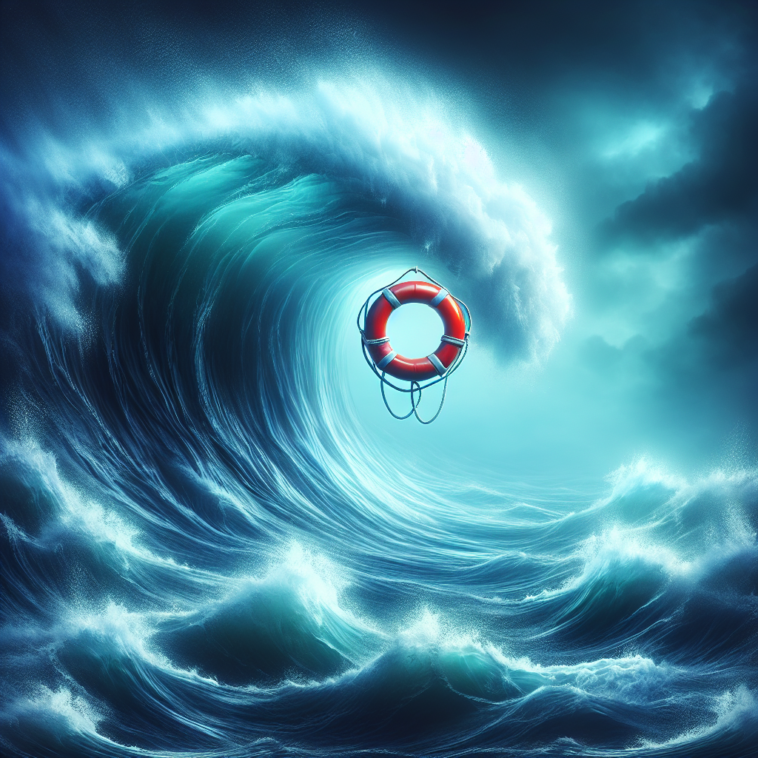Imagine yourself in the middle of the vast ocean, surrounded by nothing but rough seas and towering waves. The relentless crashing of water against your vessel is enough to make your heart race. In this article, we will explore some effective strategies on how to handle and navigate through these treacherous conditions. Whether you are a seasoned sailor or an adventurous soul setting out on a daring voyage, these tips will equip you with the knowledge and confidence needed to conquer the roughest of seas. So, batten down the hatches, because we’re about to embark on a wild ride through the stormy waters.
Understanding the Conditions
Navigating through rough seas and high waves can be a challenging and potentially dangerous task. It requires both knowledge and skill to safely handle your boat in these conditions. To begin, it is important to understand the weather forecast and the difference between rough seas and high waves.
Knowing the Weather Forecast
Before heading out to sea, it is crucial to check and understand the weather forecast. Keep an eye out for any warnings or advisories that may indicate rough seas or high waves. This information will help you assess whether it is safe to venture out and prepare accordingly.
Recognizing Rough Seas vs. High Waves
Rough seas and high waves are often used interchangeably, but they actually have different meanings. Rough seas refer to overall challenging conditions caused by factors such as wind, current, and tide. On the other hand, high waves specifically indicate large swells or waves. Understanding these distinctions will help you anticipate and handle the conditions you might encounter.
Preparing Your Boat
Preparing your boat is an important step in ensuring your safety and the safety of your crew when facing rough seas and high waves. Take the time to thoroughly check your safety equipment, secure loose items, and clear the deck.
Checking Safety Equipment
Before setting sail, make sure all safety equipment is in good working condition. This includes life jackets, flares, fire extinguishers, and navigation lights. Inspect and test each item to ensure they are functioning properly. It is also a good idea to have a first aid kit readily available in case of emergencies.
Trimming and Securing
Properly trimming your boat is crucial in rough conditions. Adjusting the sails and rigging to balance the boat can increase stability and control. Additionally, ensure that all items on board are properly secured. Loose items can become dangerous projectiles in rough seas, so stow them away or secure them with bungee cords or lashing.
Clearing the Deck
A cluttered deck can hinder movement and increase the risk of accidents. Before setting sail, clear the deck of any unnecessary items or equipment. This will allow for better mobility and prevent anything from impeding navigation or causing injury during rough conditions.
Stowing Loose Items
As mentioned earlier, loose items on board can pose a significant risk in rough seas. Take the time to stow away any loose gear, such as fishing equipment, tools, or spare parts. Secure them in lockers or storage compartments to prevent them from shifting or falling overboard.
Safe Navigation Techniques
Navigating safely through rough seas and high waves requires a set of techniques to maintain control and minimize risk. It is important to maintain a proper speed, avoid rough patches, utilize navigation aids, monitor depth and waves, and keep a steady course.
Maintaining a Proper Speed
Slowing down your boat in rough conditions helps maintain control and stability. Adjust your speed to match the prevailing conditions, taking into account factors such as wind speed, wave height, and the capabilities of your vessel. It is better to err on the side of caution and travel at a slower speed to ensure a safer journey.
Avoiding Rough Patches
Rough seas are often characterized by areas of particularly challenging conditions, referred to as rough patches. These can be caused by factors such as strong currents, changing tides, or shallow areas. To navigate safely, try to avoid these rough patches by studying navigation charts and using your best judgment. If you do encounter a rough patch, steer clear of potential hazards and navigate around it with caution.
Using Navigation Aids
In rough seas, visibility can be reduced, making it important to rely on navigation aids such as GPS, radar, and charts. These tools assist in determining your position, plotting a safe course, and identifying any potential obstacles or hazards ahead. Familiarize yourself with the use of these aids and have them readily accessible when navigating through challenging conditions.
Monitoring Depth and Waves
Rough seas often come hand in hand with unpredictable waves and changing water depths. Regularly monitor the depth of the water using a depth sounder or by visually observing the color and movement of the water. Be cautious of sudden changes in wave height or direction and adjust your course accordingly to maintain control of your boat.
Keeping a Steady Course
To navigate safely through rough seas, it is important to maintain a steady course as much as possible. Avoid abrupt changes in direction or speed, as this can increase the risk of capsizing or losing control. Instead, make gradual adjustments and anticipate the movements of your boat in response to the waves and conditions.
Skillful Steering and Handling
Steering and handling your boat in rough seas and high waves require a combination of understanding the helm, utilizing the power of the waves, adjusting trim and balance, and maintaining a stable heading.
Understanding the Helm
The helm is where you control the direction and movement of your boat. In rough seas, it is important to have a firm grip on the helm and maintain full control. Understand how your boat responds to your steering inputs and be prepared for any sudden movements caused by the waves.
Using the Power of the Waves
In some cases, you can use the power of the waves to your advantage. By angling your boat correctly, you can ride the waves and reduce the resistance against your vessel. This technique, commonly known as surfing, helps maintain control and may provide smoother sailing in rough conditions. However, it is important to exercise caution and maintain balance to prevent broaching or capsizing.
Adjusting Trim and Balance
The trim and balance of your boat play a significant role in handling rough seas. Trim refers to the fore and aft balance of your boat, while balance refers to the side-to-side distribution of weight. Adjusting trim by optimizing sail settings and shifting weight within your boat can help improve stability and control in challenging conditions.
Maintaining a Stable Heading
In rough seas, maintaining a stable heading can be challenging. The constant motion of the waves can cause your boat to yaw or veer off course. To counteract this, anticipate the movement and adjust your helm inputs accordingly. By maintaining a stable heading, you can better control your boat and reduce the chance of accidents.
Maintaining Communication
Effective communication is crucial when facing rough seas and high waves. Establishing a watch system, using maritime radio, and signaling for help are important aspects of maintaining communication in challenging conditions.
Establishing a Watch System
When navigating through rough seas, it is essential to have a watch system in place. This system involves assigning crew members specific times to be on watch, ensuring that someone is always alert and aware of the boat’s surroundings. By maintaining a watch system, you can respond quickly to any changes or emergencies that arise during the journey.
Using Maritime Radio
In emergency situations or when communication with other vessels is necessary, maritime radio is an invaluable tool. Ensure that your boat is equipped with a functioning VHF radio and familiarize yourself with its operation. Stay informed about the appropriate frequencies and protocols for distress calls or safety communications.
Signaling for Help
In the event of an emergency, signaling for help is vital. Carry appropriate signaling devices such as flares or an EPIRB (Emergency Position Indicating Radio Beacon) and know how to use them effectively. These devices can attract attention and assist rescue teams in locating your position.
Ensuring Crew Safety
The safety of your crew should be a top priority when navigating through rough seas and high waves. Taking measures such as wearing life jackets, securing crew on deck, and implementing buddy systems can help protect everyone on board.
Wearing Life Jackets
In rough conditions, it is essential that all crew members wear a properly fitted life jacket at all times. Life jackets provide flotation and increase the chance of survival in the event of an accident or capsize. Ensure that each crew member has a Coast Guard-approved life jacket that is appropriate for their size and weight.
Securing Crew on Deck
When conditions get rough, it is important to secure crew members on deck to prevent injuries or falls overboard. Use harnesses or safety lines to keep crew members connected to the boat and ensure that they are positioned in safe areas away from areas of potential danger. Regularly check the condition and integrity of these safety devices to ensure their effectiveness.
Implementing Buddy Systems
The buddy system is a simple yet effective technique to enhance crew safety. Pair crew members together, with each person responsible for keeping an eye on their partner and providing assistance if needed. By implementing the buddy system, you can enhance situational awareness and ensure that no one is left unattended in challenging conditions.
Dealing with Emergency Situations
While prevention is key, it is also important to be prepared for emergency situations that may arise when navigating through rough seas. Managing capsizing, overcoming structural damage, and handling man overboard scenarios require both knowledge and practice.
Managing Capsizing
Capsizing, or overturning, is a potential risk in rough seas. If your boat capsizes, it is important to remain calm and act quickly. Stay with the boat and use any flotation devices available to keep yourself and your crew afloat. Follow proper capsize procedures, such as climbing onto the overturned hull if possible, and wait for rescue or self-recovery if conditions allow.
Overcoming Structural Damage
In rough conditions, your boat may sustain structural damage. It is crucial to have a basic understanding of boat repair and carry essential tools or materials needed for temporary fixes. Quickly assess the damage and take appropriate measures to prevent further harm or flooding. If necessary, be prepared to call for assistance or activate your distress signals.
Handling Man Overboard
The risk of someone falling overboard is heightened during rough seas. If a crew member goes overboard, it is important to act swiftly and follow proper procedures. Keep an eye on the person in the water, throw flotation devices to them, and initiate a man overboard procedure. Alert the rest of the crew, use your VHF radio to call for help, and try to bring the person back on board utilizing any available recovery equipment.
Mitigating Sea Sickness
Sea sickness can affect anyone, regardless of their experience at sea. In rough seas, the likelihood of feeling seasick is increased. Taking steps to eliminate potential triggers, choosing the right medication, applying pressure techniques, and focusing on the horizon can help alleviate symptoms.
Eliminating Potential Triggers
Certain triggers can worsen seasickness, so it is important to eliminate them as much as possible. Avoid consuming heavy or greasy meals before a trip, and opt for lighter, easily digestible snacks instead. Stay hydrated and avoid alcohol or caffeine, as these can exacerbate the symptoms. It can also help to avoid reading or focusing on small objects for prolonged periods.
Choosing the Right Medication
There are over-the-counter medications available that can help alleviate seasickness symptoms. Consult with a healthcare professional to determine the most suitable medication for you and your crew. It is important to read and follow the instructions carefully, as some medications may cause drowsiness or other side effects.
Applying Pressure Techniques
Pressure techniques, such as wearing acupressure bands or applying pressure to specific points on the body, can provide relief from seasickness. Acupressure bands, which apply pressure to the wrists, can help reduce nausea and dizziness. Additionally, applying pressure to the P6 point on the inner forearm can also alleviate symptoms.
Focusing on the Horizon
When feeling seasick, focusing on a fixed point on the horizon can help reduce the disorientation and nausea. By visually fixating on a stable object in the distance, such as a distant shoreline or a prominent landmark, you can provide your brain with a stable frame of reference and minimize the perceived motion of the boat.
Staying Calm and Focused
Maintaining a calm and focused mindset is crucial when facing rough seas and high waves. Remaining confident in your abilities, managing anxiety, fostering a positive mental attitude, and concentrating on tasks will contribute to your overall safety.
Remaining Confident
Believing in your skills and the capabilities of your boat is essential when navigating through challenging conditions. Remember the training and experience you have gained, and trust your ability to handle the boat in rough seas. Maintaining confidence will help you make better decisions and minimize panic in unexpected situations.
Managing Anxiety
Feeling anxious is not uncommon when facing rough seas, but it is important to manage these emotions effectively. Take deep breaths and focus on maintaining a steady rhythm. Acknowledge and address any concerns or worries, but also remind yourself of the preparations and precautions you have taken to ensure safety.
Positive Mental Attitude
Having a positive mental attitude can greatly impact your ability to handle rough seas. Understand that challenging conditions are part of the adventure and an opportunity to improve your skills. Embrace the experience and approach it with a positive mindset. This will not only enhance your overall experience but also contribute to maintaining a calm and focused demeanor.
Concentrating on Tasks
In rough seas, the ability to prioritize and focus on tasks is crucial. Divide tasks among crew members and communicate effectively to ensure that everything is attended to. Avoid distractions and concentrate on one task at a time, maintaining a methodical approach. By focusing on tasks, you can better manage the challenges and maintain control.
Continuous Learning and Practice
Navigating through rough seas and high waves requires continuous learning and practice. By taking seamanship courses, participating in safety drills, and learning from experienced sailors, you can enhance your skills and knowledge in handling challenging conditions.
Taking Seamanship Courses
Seamanship courses provide valuable theoretical knowledge and practical skills necessary for sailing in rough seas. These courses cover topics such as boat handling techniques, navigation, weather interpretation, and emergency procedures. By enrolling in these courses, you can learn from experienced instructors and gain insights that will contribute to your confidence and ability to navigate safely.
Participating in Safety Drills
Regular safety drills are essential for maintaining preparedness and practicing emergency procedures. Conducting drills such as man overboard scenarios, capsize recoveries, and damage control exercises will familiarize the crew with proper techniques, enhance coordination, and ensure that everyone knows their role in case of emergencies. By practicing regularly, you will be better equipped to handle challenging situations.
Learning from Experienced Sailors
Experienced sailors have a wealth of knowledge and practical experience navigating through rough seas. Engage with experienced sailors, whether through joining sailing clubs or participating in races, to learn from their insights and gain valuable advice. Their tips and experiences can provide invaluable guidance and help you improve your skills.
In conclusion, navigating through rough seas and high waves requires careful planning, preparation, and skillful execution. Understanding the weather forecast, preparing your boat, employing safe navigation techniques, skillful steering, maintaining communication, ensuring crew safety, handling emergencies, mitigating seasickness, staying calm and focused, and continuously learning and practicing will contribute to a safe and enjoyable sailing experience. By following these guidelines and honing your skills, you can confidently navigate through rough conditions and overcome the challenges of the open sea. Stay vigilant, be prepared, and embrace the adventure. Happy sailing!





